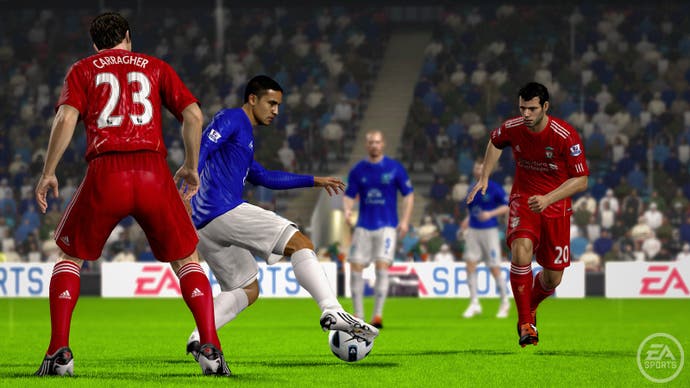FIFA 11
It ain't over until some people are on the pitch.
Last year, we thought it was all over. FIFA 10 was excellent and its advantage over rival Pro Evolution Soccer seemed greater than ever. Developer EA Canada still had a lot of work to do - Manager Mode was broken in places, keepers could be idiots and there was a clockwork precision to passing and moving that grated over time - but with a year of development and all the momentum, a sudden turnaround in fortunes looked about as likely as a Northampton win at Anfield in the Carling Cup.
Big changes this year have come in response to fan feedback, and the result is a game where your mileage will vary almost second to second. Spend a few minutes mucking around with a player in Arena mode - the interactive load screen where you're one-on-one with a goalkeeper - and you realise that no two shots are the same. Successful passing sequences used to be about movement, timing and very little else, but now they are also beholden to a player's inherent skill, the speed they're moving at, whether they're off-balance and all sorts of other quiet stats.
Passes also need to be better timed and weighted by you using a new passing meter, and you will need to be aware that the ball is more likely to deflect or be intercepted than in FIFA 10. Ball trajectory and pace have become wild cards, and so Wayne Bridge is not going to fluke a goal from the halfway line when you're 3-0 up any more, and there isn't as much point going short at a goal kick, because you won't be able to zigzag the ball past the centre circle without running into trouble or losing your composure. The crazy videogame stuff has virtually disappeared.

Heading has also changed, as you have more direct movement control of players on the receiving end. In our early multiplayer games this led to a flood of goals from crosses, but with practice you can often overcome this by positioning your defender more carefully. It also means you can do some interesting things in open play - when a goal kick is soaring upfield, a smart striker can sometimes muscle a hapless centre-half under the flight of the ball and attempt to run onto it.
Goalkeepers have also had some work done - or at least some work done for them. FIFA 10 was eventually pilloried for the ease with which charging goalkeepers could be lobbed, so this summer's World Cup release glued them to their six-yard boxes with double-edged results - most of our goals would eventually be scored by breaking into the box and using the through-ball button to roll the ball left or right to a team-mate for a tap-in. FIFA 11's solution is to make lobs rubbish. We've yet to score one. EA says it has also given goalies more distinctive personalities and better perception, although that one's going to be hard to call for a while.
Off the pitch, EA has condensed Be A Pro and Manager Mode into a single, all-encompassing Career Mode, where you choose to be a player, player-manager or manager across 15 seasons. Transfers now involve separate fee and wage negotiations, coaching feedback is more detailed and relevant, and if you opt for player or player-manager roles you can choose to play as an individual or the whole team when you take manual control. Management is a bit light on detail if you decide not to play the matches yourself, but there's always Football Manager 2011 if you're that way inclined, and FIFA 11 hardly pretends to compete with that.


